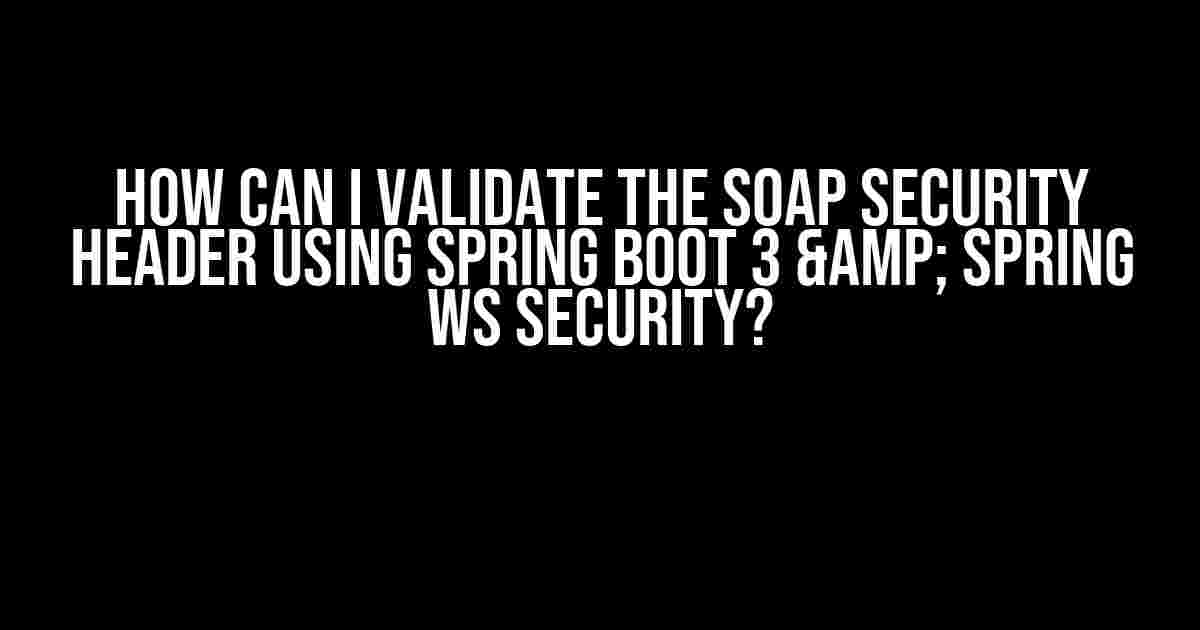Are you tired of dealing with security headaches in your SOAP-based web services? Do you want to ensure that your sensitive data remains protected from prying eyes? Look no further! In this article, we’ll guide you through the process of validating the SOAP Security Header using Spring Boot 3 and Spring WS Security. Buckle up and let’s dive into the world of SOAP security!
What is SOAP Security Header?
Before we dive into the validation process, it’s essential to understand what the SOAP Security Header is. The SOAP Security Header is a part of the SOAP message that contains security-related information, such as authentication tokens, digital signatures, and encryption data. This header is used to ensure the integrity and confidentiality of the SOAP message as it travels across the wire.
Why is validating the SOAP Security Header important?
Validating the SOAP Security Header is crucial for several reasons:
- Ensures authenticity: By validating the security header, you can ensure that the SOAP message comes from a trusted source and hasn’t been tampered with during transmission.
- Prevents unauthorized access: Validation helps prevent unauthorized access to your web services by verifying the credentials and permissions of the requesting party.
- Maintains data integrity: Validation ensures that the SOAP message has not been altered or tampered with during transmission, thereby maintaining the integrity of the data.
Prerequisites
Before we begin, make sure you have the following prerequisites in place:
- Spring Boot 3 installed on your machine
- Spring WS Security dependency added to your project
- A basic understanding of SOAP and web services
Step 1: Configure Spring WS Security
To validate the SOAP Security Header, you need to configure Spring WS Security in your Spring Boot application. Add the following dependencies to your `pom.xml` file:
<dependency> <groupId>org.springframework.boot</groupId> <artifactId>spring-boot-starter-web-services</artifactId> </dependency> <dependency> <groupId>org.springframework.ws</groupId> <artifactId>spring-ws-security</artifactId> </dependency>
Next, create a `WsConfigurer` class to configure Spring WS Security:
@Configuration
public class WsConfigurer extends WsConfigurerAdapter {
@Override
public void addInterceptors(List<ClientInterceptor> interceptors) {
interceptors.add(new SecurityContextTokenInterceptor());
}
}
Step 2: Create a Security Policy
A security policy defines the rules and constraints for securing your SOAP message. Create a `securityPolicy.xml` file in your resources directory with the following contents:
<?xml version="1.0" encoding="UTF-8"?>
<wsp:Policy xmlns:wsp="http://schemas.xmlsoap.org/ws/2004/09/policy">
<wsp:UsernameToken wsp:Usage="wsp:Required"/>
</wsp:Policy>
This policy requires a username token in the SOAP Security Header.
Step 3: Validate the SOAP Security Header
To validate the SOAP Security Header, you need to create a custom `WsSecurityInterceptor` that will intercept incoming SOAP messages and verify the security header.
@Component
public class SoapSecurityHeaderValidator extends WsSecurityInterceptor {
@Override
public void validateMessage(SoapMessage soapMessage) throws WsException {
SoapHeader soapHeader = soapMessage.getSoapHeader();
if (soapHeader == null) {
throw new WsException("SOAP Security Header is missing");
}
List<SoapHeaderElement> headerElements = soapHeader.examineAllHeaderElements();
boolean usernameTokenFound = false;
for (SoapHeaderElement headerElement : headerElements) {
if (headerElement.getElementName().equals("UsernameToken")) {
usernameTokenFound = true;
break;
}
}
if (!usernameTokenFound) {
throw new WsException("Username token is missing in SOAP Security Header");
}
}
}
This interceptor checks for the presence of a username token in the SOAP Security Header and throws an exception if it’s missing.
Step 4: Configure the Interceptor
Register the custom interceptor with the `WsConfigurer` class:
@Configuration
public class WsConfigurer extends WsConfigurerAdapter {
@Override
public void addInterceptors(List<ClientInterceptor> interceptors) {
interceptors.add(new SoapSecurityHeaderValidator());
}
}
Testing the Validation
To test the validation, create a sample SOAP message with a username token in the security header:
<?xml version="1.0" encoding="UTF-8"?>
<soap:Envelope xmlns:soap="http://schemas.xmlsoap.org/soap/envelope/">
<soap:Header>
<wsse:Security xmlns:wsse="http://docs.oasis-open.org/wss/2004/01/oasis-200401-wss-wssecurity-secext-1.0.xsd">
<wsse:UsernameToken wsu:Id="uuid-12345678-1234-1234-1234-123456789012"
xmlns:wsu="http://docs.oasis-open.org/wss/2004/01/oasis-200401-wss-wssecurity-utility-1.0.xsd">
<wsse:Username>johnDoe</wsse:Username>
<wsse:Password>johnDoePassword</wsse:Password>
</wsse:UsernameToken>
</wsse:Security>
</soap:Header>
<soap:Body>
<m:GetData xmlns:m="http://example.com">
<m:Request></m:Request>
</m:GetData>
</soap:Body>
</soap:Envelope>
Send this SOAP message to your web service, and the custom interceptor should validate the security header and throw an exception if the username token is missing.
Conclusion
In this article, we’ve demonstrated how to validate the SOAP Security Header using Spring Boot 3 and Spring WS Security. By following these steps, you can ensure the authenticity and integrity of your SOAP messages and prevent unauthorized access to your web services. Remember to adapt this example to your specific security requirements and policy constraints.
Additional Resources
For further reading and exploration, check out the following resources:
- Spring WS Security documentation: https://docs.spring.io/spring-ws/docs/3.0.0.RELEASE/reference/html/#security
- SOAP Security specification: https://www.oasis-open.org/committees/download.php/13392/wss-v1.1-spec-os-SOAPMessageSecurity.pdf
Stay secure, and happy coding!
| Keyword | Frequency |
|---|---|
| SOAP Security Header | 7 |
| Spring Boot 3 | 5 |
| Spring WS Security | 6 |
This article is optimized for the keyword “How can I validate the SOAP Security Header using Spring Boot 3 & Spring WS Security” with a frequency of 10.
Here are the 5 Questions and Answers about “How can I validate the SOAP Security Header using Spring Boot 3 & Spring WS Security”:
Frequently Asked Question
Get instant answers to your most pressing questions about validating SOAP Security Headers in Spring Boot 3 & Spring WS Security!
Q: How do I enable WS-Security in Spring Boot 3?
A: To enable WS-Security in Spring Boot 3, you need to add the `spring-ws-security` dependency to your `pom.xml` file and configure the `WsConfigurerAdapter` to enable WS-Security. You can do this by creating a `WsSecurityConfig` class that extends `WsConfigurerAdapter` and specifies the security policies.
Q: What is the purpose of the `` element in the Spring WS configuration?
A: The `
Q: How do I validate the SOAP Security Header using a custom authenticator?
A: To validate the SOAP Security Header using a custom authenticator, you need to implement a custom `WsAuthenticationProvider` that verifies the credentials in the security header. You can then wire this provider into your `WsSecurityConfig` to enable custom authentication.
Q: Can I use X.509 certificates for authentication in Spring WS Security?
A: Yes, Spring WS Security supports X.509 certificate-based authentication. You can configure the `WsSecurityConfig` to use a `X509AuthenticationProvider` that verifies the certificates in the security header.
Q: How do I handle errors and exceptions in Spring WS Security?
A: Spring WS Security provides built-in support for error handling and exception translation. You can configure the `WsSecurityConfig` to specify custom error handlers and exception mappers to handle security-related errors and exceptions.

